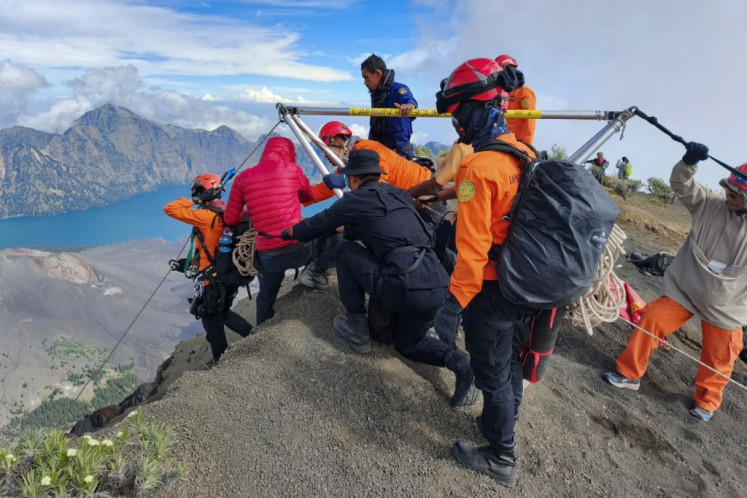Popular Reads
Top Results
Can't find what you're looking for?
View all search resultsPopular Reads
Top Results
Can't find what you're looking for?
View all search results‘Becoming Leonardo Da Vinci — An Impossible Interview’ reveals painter’s great thoughts but keeps ‘Mona Lisa’ secret
Courtesy of Italian Cultural Institute JakartaLearning never exhausts the mind - Leonardo Da Vinci
Change text size
Gift Premium Articles
to Anyone
Courtesy of Italian Cultural Institute Jakarta
Learning never exhausts the mind - Leonardo Da Vinci.
When it comes to Leonardo Da Vinci, some may quickly associate him with his famous masterpiece the Mona Lisa, which continues to arouse curiosity until this day. The original painting of the Mona Lisa with its ambiguous look is on permanent display at the Louvre Museum in Paris, France.
The reproduction of the model, however, can be found in many places across the globe. Street painters, several of whom live and try their luck in Jakarta, can also be found displaying their version of the Mona Lisa portrait among their artwork.
The intriguing questions are, “What is her identity and who is really hiding behind her face?”
The performance of Becoming Leonardo Da Vinci — An Impossible Interview by Massimiliano Finazzer Flory in Jakarta recently did not skip the above questions and the interviewer even addressed the Mona Lisa issue to open and end the 70-minute one-act play.
The performance, a special treat for Jakarta’s theater enthusiasts, took place at the Institut Français d’Indonésie in Jakarta on March 30. It was organized by the Italian Embassy and Instituto Italiano Di Cultura Jakarta (the Italian Cultural Institute Jakarta) in collaboration with Institut Français d’Indonésie.
Along with Leonardo’s Lady with an Ermine, Mona Lisa and a canvas decorated the stage of the Institut Français d’Indonésie auditorium, strongly supporting Leonardo Da Vinci’s presence as a painting maestro.
Renowned actor and director Massimiliano Finazzer Flory became Leonardo physically, wearing costumes from the Renaissance period in 15th century, with make-up that was a true reconstruction of the face of genius from Vinci.
The one-act play opened with the interviewer played by Jacopo Rampini saying, “It is for the first time ever tonight in Jakarta we’ll find the truth about Mona Lisa, what is her identity, who is really hiding behind her face [...] So maestro, let’s begin. How would you call yourself artist, scientist, engineer, painter or architect?”
The long-bearded “Leonardo” of Finazzer Flory answers the questions in Renaissance Italian, using the authentic word for Leonardo. Projected contemporary English text was available on screen to help those who do not speak Renaissance Italian to understand the answers.
Soon after the first questions were answered, Leonardo was bombarded with other questions pertaining to various issues such as the arts and nature, color, nutrients, flying machines, the relationship between painting and science, painting and sculpture and painting and music.
In answering the questions, Finazzer Flory made movements and used hand gestures and facial expressions as if he were the real Leonardo Da Vinci at 60’s. Medieval music was sometimes implanted into the conversation, creating a mysterious but contemplative and reflective atmosphere.
Despite the solemn, contemplative and thought-provoking atmosphere presented throughout the performance, Leonardo delivered one or two jokes, which pleased the audience. In one of his answers to a question on painters, he says, “Although the poet has as wide a choice of subjects as the painter, his creations fail to afford as much satisfaction to mankind as do paintings [...] if the poet serves the understanding by way of the ear, the painter does so by the eye, which is the nobler sense.”
“The painter has the universe in his mind and hands.”
Upon receiving the answer, the interviewer says, “I think you might be overestimating the role of a painter, maestro?”
Leonardo said, “Astaga…[dear me],” which drew laughter from the audience.
Leonardo is also known for having a concept of the flying machine. “Let’s imagine if you’re flying machine actually works, how would you use it?” asked the interviewer.
“... Jakarta [Flying to Jakarta],” he said, laughing.
The interview reached its climax when the interviewer said he wanted to keep the promise of ending the interview with a long-awaited question on Mona Lisa.
Leonardo kept quiet for a moment, immersing himself in his own thoughts, but a few moments later he walked toward the interviewer and whispered something in his ear. There was a pause, but the interviewer said nothing to the audience, which included Italian Ambassador to Indonesia Vittorio Sandalli, as if he wanted to keep the whisper a secret.
The performance of Becoming Leonardo Da Vinci — An Impossible Interview was worth seeing. The audience had the freedom to interpret the message behind the impossible interview.
To some extent, the performance seemed to want to reaffirm the importance of critical thinking skills, curiosity, passion for learning and inventing things in today’s rapidly changing environment.
After the performance, Finazzer Flory said being a Renaissance man was the most interesting part of being Leonardo even though it required him to prepare for years.
He said he had to learn Leonardo’s body movements, emotions and his authentic language.
“You know that Leonardo is multi-talented man.”
Leonardo’s legacy to the modern era, according to him, is the truth, “but not ideological truth. You must undergo trials and errors. Another thing is the quality of intelligence. Leonardo’s natural genius crossed so many disciplines and this can serve as an inspiration to all, your people, teachers, engineers, poor people, all who enjoy beauty,” he said.
Michela Linda Magri, director of Instituto Italiano Di Cultura Jakarta, meanwhile, said Leonardo had a strong relationship with France. Between 1516 and 1519, he traveled to France. He died at Cloux (now Clos-Luce) in 1519 aged 67.
“His most famous masterpieces, Mona Lisa and The Virgin and the Child with St Anne can be found at the Louvre Museum in France. That’s the reason why we held the performance at Institut Français d’Indonésie,” she said enthusiastically.
The performance itself was a great success. It attracted many theater enthusiasts, many of whom were students. Those who came late were unable to find empty seats and resorted to standing.
The great interest of the students in the performance was understandable because aside from his masterpieces, Leonardo Da Vinci is also well recognized for his quotes, which many enjoy as lifelong advice. Apart from the aforementioned quotes, another famous one is: “The noblest pleasure is the joy of understanding.”










